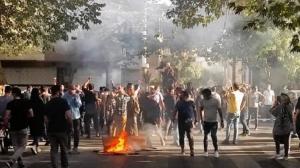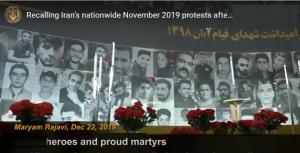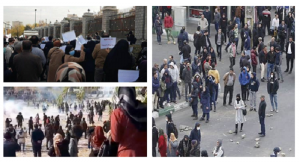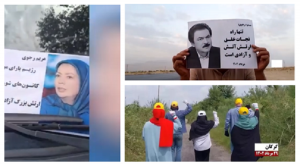(Video) A Year On: The Ongoing Impact of Iran’s Nationwide Uprising

The (NCRI) Foreign Affairs Committee in an article titled "A Year On The Ongoing Impact of Iran’s Nationwide Uprising" stated that this report delves into the nationwide uprising that occurred in Iran in 2022 to foster democratic change.

Since the 2017 uprising, several significant incidents, such as the massacre of at least 1,500 protesters in the 2019 crackdown, the pandemic, and the appointment of a notorious executioner as president, served to further contribute to the combustible mixture.

Being inspired by tens of thousands of women who were arrested, endured torture, and many were executed during the past four decades, women exhibited remarkable leadership and resilience, thereby significantly amplifying the movement’s overall impact.
Iran’s society, akin to a powder keg, was ignited by an array of grievances encompassing political oppression, economic turmoil, and systemic corruption.
The uprising, which erupted following years of suppressed dissatisfaction, was triggered by a society that bore a striking resemblance to a highly volatile powder keg, just waiting for the slightest spark to set it ablaze.
Iran’s society, akin to a powder keg, was ignited by an array of grievances encompassing political oppression, economic turmoil, and systemic corruption.
Since the 2017 uprising, several significant incidents, such as the massacre of at least 1500 protesters in the 2019 crackdown, mishandling of the pandemic response, and the appointment of a notorious executioner as president, only served to further contribute to the combustible mixture.
The prevalent issues of widespread inflation, unemployment, and poverty further stoked the flames of societal unrest.
Key to driving this uprising were women, who played a pivotal role in propelling the movement forward.
Being inspired by tens of thousands of women who were arrested, endured torture, and many were executed during the past four decades, women exhibited remarkable leadership and resilience, thereby significantly amplifying the movement’s overall impact.
The sustainability of this uprising hinges upon the volatile climate within society and the catalytic influence of the organized resistance. While the regime strives to suppress the MEK and its network of Resistance Units, this effort underscores the movement’s appeal, particularly among Iran’s younger generation.
Caught in a strategic quagmire, the regime cannot address public grievances or return to the previous state before the uprising. The yearning for transformation within Iranian society rejects both the current clerical dictatorship and the former monarchy.
The regime’s attempts to suppress the movement have proven ineffective in quelling the uprising, thus leaving society in a state reminiscent of a powder keg on the brink of explosion.
Beneath the regime’s suppression tactics lies an underlying societal volatility, with economic hardships, political repression, and corruption collectively fueling a widespread sense of discontent.
As the anniversary of the uprising approaches, the regime finds itself grappling with a society teetering on the edge, where the likelihood of a democratic spark igniting becomes increasingly plausible.
Introduction
Iran is fast approaching the first anniversary of the latest round of popular uprisings that waged across the entire country, continued for several months, and changed the country’s socio-political landscape for good.
As the people and the state are preparing themselves in opposite ways, the circumstances and underlying dynamics have fueled the society with more reasons for revolt.
In addition to enduring grievances such as the severe repression of political dissent, the erosion of civil liberties, and pervasive censorship, the regime has rendered life unbearable for the majority of Iranians who have been thrust below the poverty line in recent years.
At the anniversary of the nationwide uprising, the core question is: Has the regime managed to quell the protests, and are we back to the status quo before the start of the protests, or do the protests live on, and is the Iranian society getting ready for even bigger events?
In this paper, we will shortly examine Iran’s 2022 nationwide uprising, its root causes and its impact on Iranian society, and how the future will unfold.
The Root Causes of Iran’s Uprisings
Iran, under the rule of the mullahs, is a hotbed of human rights abuses, torture, execution, and the killing field for innocent men, women, and children.
The uprising is not a sudden event that lacks any roots. Instead, it is the product of the Iranian people’s struggle for freedom over the past four decades, for which 120,000 freedom fighters have sacrificed their lives.
Since the 2017 uprising, several significant incidents have built up substantial and explosive anti-regime rage in Iranian society. The first was the massacre of at least 1,500 protesters in 2019, followed by the IRGC’s deliberate downing of a Ukrainian passenger airliner. Then came 550,000 deaths caused by the spread of the coronavirus, exacerbated by Khamenei’s decisions.
Another was the appointment of Ebrahim Raisi, the executioner of the 1988 massacre of 30,000 political prisoners, as the regime’s president.
High inflation, which sometimes reaches 100% for some commodities, rampant and horrible unemployment, state corruption that affects all aspects of life, and discrimination against women and religious and ethnic minorities have created an explosive society.
In the past five years, the country’s low-income population has tripled. The brutal suppression of women and youth, as well as the worsening poverty and unemployment, have dismayed everyone.
There has been zero economic growth over the past decade, the investment rate is negative, and the value of the national currency has plunged by 34 times.
Therefore, this uprising has its roots in the explosive state of society, poverty, unemployment, and, above all, the catastrophic situation of women. The 2022 uprising was an eruption of anger and pain caused by these factors.
The Role of Women
The historical trajectory of women’s involvement in the battle against the mullahs is rich and enduring. Iranian women have been steadfast participants in the quest for freedom for over four decades, actively engaging in the struggle.
Furthermore, within the ranks of the Iranian Resistance, women have consistently held positions of authority and responsibility.
In the context of the uprising, Iranian women’s defiance extended beyond merely discarding the mandatory veil; it encompassed a resolute rejection of all forms of coercive and autocratic governance, whether perpetrated by the Shah or the mullahs.
The uprising’s emergence was not a sudden occurrence, and the pivotal role assumed by women was not a happenstance. On one hand, the uprising was the culmination of more than 40 years of relentless struggle by the Iranian populace and the resistance, a struggle marked by significant sacrifices.
On the other hand, the influence of women in the leadership echelons of the resistance over the preceding decades significantly contributed to the movement’s development.
The prominent involvement of women in propelling the uprising stems from a reaction to 44 years of suppression. This catalytic role is deeply intertwined with the efforts of countless freedom fighters and female members of the main opposition group, the People’s Mojahedin Organization of Iran (PMOI/MEK), who, over these years, endured imprisonment, torture, and execution in their pursuit of emancipation.
The engagement of women at all tiers of the Iranian Resistance has yielded a substantial reservoir of capability among Iranian women. Across nearly four decades, women from diverse strata within this movement have demonstrated adept leadership and managerial skills, drawing wisdom from invaluable, often blood-soaked experiences.
In essence, the saga of women’s involvement in this narrative of resistance underscores the depth of their commitment, the caliber of their leadership, and the unwavering solidarity that they have exhibited throughout.
Sustaining the Uprising: Factors at Play
The ongoing persistence of the protests can be attributed to two primary driving forces. Firstly, the explosive state of Iranian society leaves a vast majority of its populace deeply disenchanted.
Pervasive issues such as soaring inflation, rampant and dire unemployment, widespread state-level corruption, and a backdrop of discrimination targeting women, religious minorities, and ethnic groups have collectively engendered an atmosphere of explosive tension within the society.
Secondly, a well-organized resistance movement operates across diverse domains. On one front, this resistance lends tangible support to the grassroots revolution while also serving as a guiding influence for the ongoing uprising, exercising a significant impact.
The network of Resistance Units established by the MEK has emerged as a potent impetus behind the wave of protests, a reality even acknowledged by the regime itself.
On August 2, 2023, IRNA, the Iranian regime’s official news agency, organized a roundtable with five of the regime’s so-called “experts” on the occasion of releasing a new book, the latest chapter in the regime’s endless demonization campaign against the MEK. The participants confessed to important points about the MEK.
It is worth noting that these individuals are security and propaganda officials and sometimes interrogators and torturers of the regime’s suppression apparatus. But the regime’s news agency, as usual, presented them with titles such as university professor, history researcher, and author.
Mohammad Atrianfar asked the question: “Why is the MEK so important? What kept it alive?”
Other participants in the roundtable each tried to answer this question.
Ebrahim Fayyaz said, “History repeats itself, and I think the MEK will probably return.” He admitted that the youth have turned away from the regime and are gravitating to the MEK and added, “Unfortunately, the Islamic Republic is not transparent to the new generation and has not been able to explain this to the youth.
The fact that the MEK is structurally still alive and a group [of people] want to join them shows that it is not just because of the support of the United States and Britain. We haven’t yet destroyed the MEK.” Of course, regime authorities always have to rehash debunked claims of associating the MEK with foreign powers because not doing so would further drive the point that the ME is a movement rooted in Iranian society.
“The fact that the MEK are alive today should be important for the government and should be examined to understand it better,” Fayyaz said.
Mohammad Quchani made the point that “the MEK has split the country.” His later explanation and the phrase “dual government and opposition” made clear that he meant that the MEK had polarized the society between the people and resistance on the one hand and the ruling regime on the other.
Quchani said, “We have to know that the Mojahedin-e Khalgh issue is the issue of our day and it is not just a historical issue.” He implicitly admitted that the MEK is a key player in leading protests against the regime, saying that “wherever the people’s rightful protests were diverted, the organization was involved.” Of course, by “diverted,” he refers to slogans that call for the overthrow of the entire regime, which is being chanted by millions of people in Iran.
He also said, “The separation of clergy and state from the people is the work of this organization.” He concluded by stressing the urgency of dealing with the Iranian Resistance: “So the issue of the MEK is today’s issue.”
Abbas Salimi Namin summarized the discussions of the roundtable as such: “Our main issue in the country is the MEK, and we must address it.”
The events of the 2022 uprising served as an unequivocal testament to the influence of the MEK on Iranian youth. The methods and tactics employed by MEK resistance units in their struggle against the regime have resonated with the younger generation.
Strategies such as the symbolic incineration of regime symbols, massive propaganda billboards, and daubing walls with protest slogans have gained traction. The MEK’s sustained involvement has galvanized nationwide protests, fostering an increasingly radicalized societal stance against the regime.
Over five years, the MEK Resistance Units have fearlessly challenged the regime’s sprawling security apparatuses, and their approach has progressively gained popularity among the nation’s youth.
Extracting Lessons from the Uprising
The nationwide upheaval that erupted across Iran in September 2022 has reverberated through the country’s political landscape, jolting its foundations.
The historical significance of such uprisings in Iran underscores a seismic shift away from an untenable status quo. The prevailing balance of power has undergone a marked transformation, leading policymakers to acknowledge that the present regime confronts an existential crisis bereft of viable remedies for its escalating predicaments.
Lesson 1: The Iranian regime is in a strategic deadlock.
The recent uprising has laid bare a glaring reality: the Iranian regime finds itself ensnared in a strategic impasse. Its failure to address the people’s grievances has left it grappling to sustain its authority.
Presently, the regime grapples with an array of setbacks, from a faltering economy and internal schisms within its ranks to the attrition of personnel within the IRGC and Basij, as well as the looming specter of the nuclear issue.
These multifaceted challenges have converged, rendering the regime incapable of instigating any reforms lest they undermine the power structure upheld by Khamenei and precipitate the regime’s total collapse.
The regime’s actions, ostensibly designed to preserve its control, inadvertently deepened public discontent, stoking the uprising.
The prospect of returning to the pre-uprising status quo has grown untenable, ultimately paving the way for the regime’s overthrow at the hands of a resolute populace and their organized resistance movement.
Lesson 2: Iranian society is primed for fundamental change.
The protests have provided unequivocal evidence that Iranian society is primed for sweeping transformation. The populace’s collective rejection of the entire regime underscores a palpable yearning for a new system that permits genuine representation.
This reflects a profound yearning for a democratic revolution, firmly rejecting any form of dictatorship, including vestiges of the former Shah’s regime. The unwavering determination for a more inclusive and participatory political structure propels the ongoing protests.
Shahin Gobadi
NCRI
+33 6 61 65 32 31
email us here
This uprising reflects a yearning for a democratic revolution, firmly rejecting any form of dictatorship, including vestiges of the former Shah’s regime.
Legal Disclaimer:
EIN Presswire provides this news content "as is" without warranty of any kind. We do not accept any responsibility or liability for the accuracy, content, images, videos, licenses, completeness, legality, or reliability of the information contained in this article. If you have any complaints or copyright issues related to this article, kindly contact the author above.


